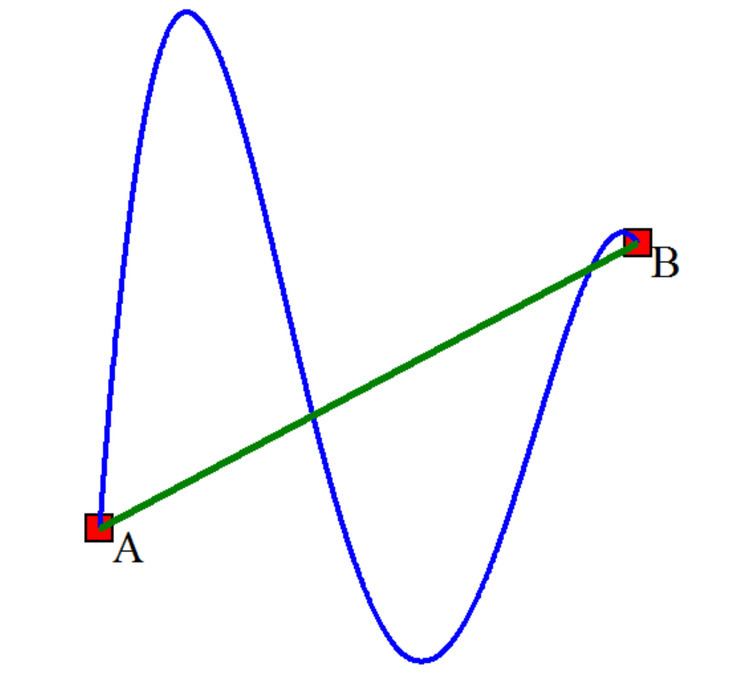 | ||
In vector calculus, a conservative vector field is a vector field that is the gradient of some function, known in this context as a scalar potential. Conservative vector fields have the property that the line integral is path independent, i.e., the choice of any path between two points does not change the value of the line integral. Path independence of the line integral is equivalent to the vector field being conservative. A conservative vector field is also irrotational; in three dimensions, this means that it has vanishing curl. An irrotational vector field is necessarily conservative provided that the domain is simply connected.
Contents
- Informal treatment
- Intuitive explanation
- Definition
- Path independence
- Irrotational vector fields
- Irrotational flows
- Conservative forces
- References
Conservative vector fields appear naturally in mechanics: They are vector fields representing forces of physical systems in which energy is conserved. For a conservative system, the work done in moving along a path in configuration space depends only on the endpoints of the path, so it is possible to define a potential energy that is independent of the path taken.
Informal treatment
In a two- and three-dimensional space, there is an ambiguity in taking an integral between two points as there are infinitely many paths between the two points — apart from the straight line formed between the two points, one could choose a curved path of greater length as shown in the figure. Therefore, in general, the value of the integral depends on the path taken. However, in the special case of a conservative vector field, the value of the integral is independent of the path taken, which can be thought of as a large-scale cancellation of all elements
Intuitive explanation
M. C. Escher's painting Ascending and Descending illustrates a non-conservative vector field, impossibly made to appear to be the gradient of the varying height above ground as one moves along the staircase. It is rotational in that one can keep getting higher or keep getting lower while going around in circles. It is non-conservative in that one can return to one's starting point while ascending more than one descends or vice versa. On a real staircase, the height above the ground is a scalar potential field: If one returns to the same place, one goes upward exactly as much as one goes downward. Its gradient would be a conservative vector field and is irrotational. The situation depicted in the painting is impossible.
Definition
A vector field
Here,
The Fundamental Theorem of Vector Calculus states that any vector field can be expressed as the sum of a conservative vector field and a solenoidal field.
Path independence
A key property of a conservative vector field
This holds as a consequence of the Chain Rule and the Fundamental Theorem of Calculus.
An equivalent formulation of this is that
for every rectifiable simple closed path
Irrotational vector fields
Let
For this reason, such vector fields are sometimes referred to as curl-free vector fields or curl-less vector fields. They are also referred to as longitudinal vector fields.
It is an identity of vector calculus that for any
Therefore, every
Provided that
The above statement is not true in general if
Then
Therefore,
In a simply connected open region, an irrotational vector field has the path-independence property. This can be seen by noting that in such a region, an irrotational vector field is conservative, and conservative vector fields have the path-independence property. The result can also be proved directly by using Stokes' theorem. In a simply connected open region, any vector field that has the path-independence property must also be irrotational.
More abstractly, in the presence of a Riemannian metric, vector fields correspond to differential
Irrotational flows
The flow velocity
A common alternative notation for vorticity is
If
Kelvin's circulation theorem states that a fluid that is irrotational in an inviscid flow will remain irrotational. This result can be derived from the vorticity transport equation, obtained by taking the curl of the Navier-Stokes Equations.
For a two-dimensional flow, the vorticity acts as a measure of the local rotation of fluid elements. Note that the vorticity does not imply anything about the global behavior of a fluid. It is possible for a fluid traveling in a straight line to have vorticity, and it is possible for a fluid that moves in a circle to be irrotational.
Conservative forces
If the vector field associated to a force
The most prominent examples of conservative forces are the gravitational force and the electric force associated to an electrostatic field. According to Newton's law of gravitation, the gravitational force
where
is the gravitational potential energy.
For conservative forces, path independence can be interpreted to mean that the work done in going from a point
The total energy of a particle moving under the influence of conservative forces is conserved, in the sense that a loss of potential energy is converted to an equal quantity of kinetic energy, or vice versa.
